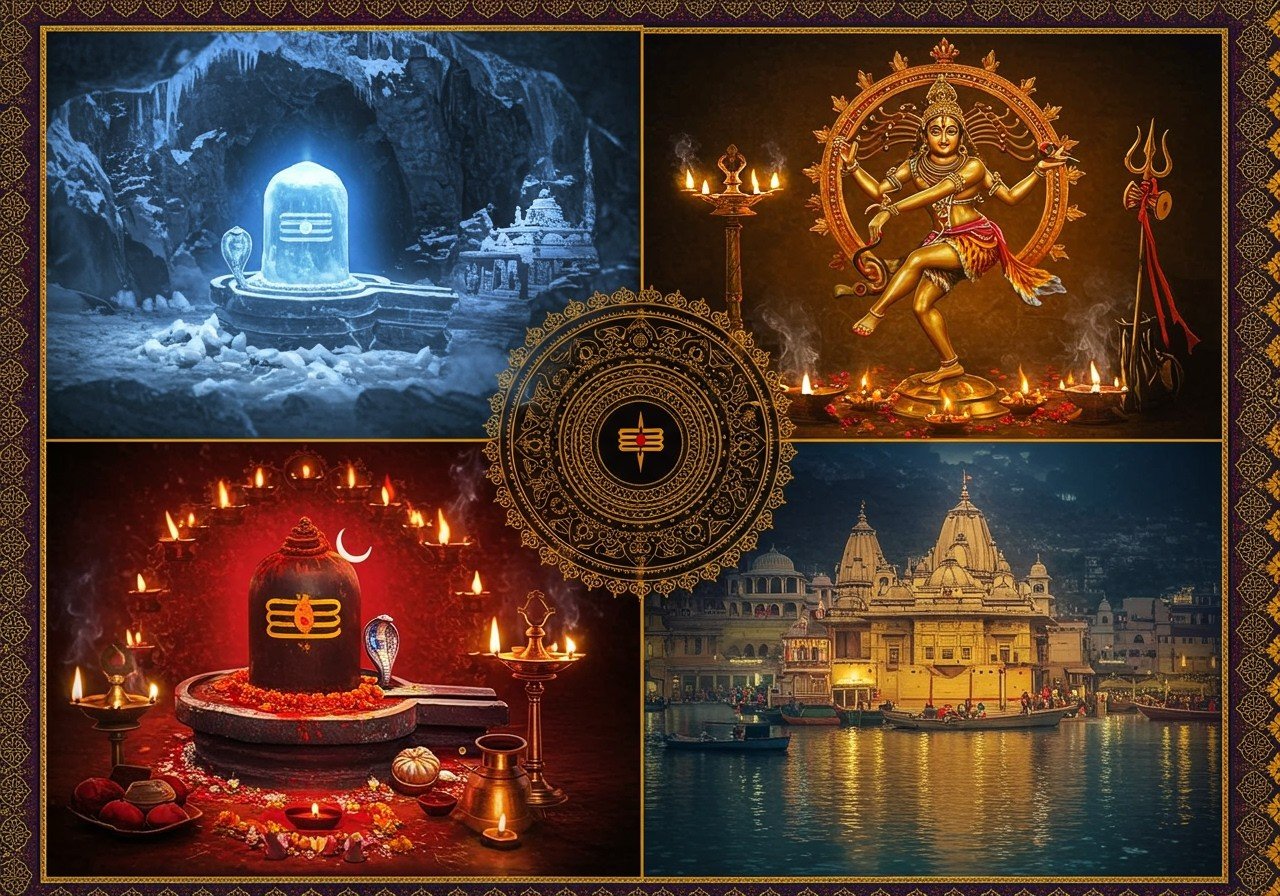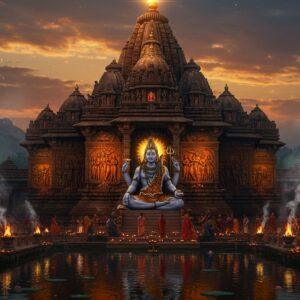
Discover the fascinating world of Shiva Puja traditions across India, where diverse cultural practices and local customs come together. Learn how different regions honor Lord Shiva with unique rituals that highlight their spiritual and cultural heritage. Explore the rich variety in these practices, which reflect the deep spiritual roots and cultural nuances of each area.
Reverence and Rituals: Shiva Puja in Andhra Pradesh and Telangana
In the heart of Andhra Pradesh and Telangana, Shiva Puja is a vibrant expression of Telugu culture and devotion. The air resonates with traditional Telugu music and devotional songs, narrating the divine tales of Lord Shiva and deepening the spiritual connection. During festivals like Maha Shivaratri, the atmosphere is electrifying, with devotees observing fasts and engaging in night-long vigils, a testament to their unwavering faith.
The Abhishekam ceremony is central to the Shiva Puja in this region. Devotees reverently bathe the Shiva Lingam with sacred substances like milk, honey, and ghee, believing it to be a purifying and sanctifying act. Offerings of locally sourced flowers, such as fragrant jasmine and vibrant marigolds, along with the sacred bilva leaves, add a touch of regional significance to the rituals.
Want to learn more about performing Shiva Puja? Read our comprehensive guide here.
Devotional Harmony: Shiva Puja Mantras in West Bengal
West Bengal’s reverence for Lord Shiva is deeply embedded in its cultural identity. Bengali mantras, imbued with linguistic beauty and spiritual depth, resonate through homes and temples. The timeless chant of “Om Namah Shivaya” echoes through generations, a sacred thread connecting families in their devotion.
The influence of revered Bengali saints and spiritual leaders has shaped the unique character of Shiva Puja in this region. Their teachings continue to inspire deep reverence and devotion. Art forms like dance and music intertwine with the rituals, creating an immersive spiritual experience.
Festivals such as Gajan offer a captivating glimpse into Bengal’s devotion. Processions filled with vibrant colours and rhythmic chants wind through the streets, as devotees express their collective reverence and joy in honoring Lord Shiva. The rhythmic chanting of mantras, accompanied by offerings of milk, honey, and bel leaves, elevates the spiritual atmosphere, fostering unity among worshippers. This unique blend of tradition and devotion sets West Bengal’s Shiva Puja apart.
Looking for information about Shiva temples? Check out our guide to Lord Shiva temples in Maharashtra here and our exploration of the Kopineshwar Mandir here.
A Glimpse into Regional Variations of Shiva Puja
Across the diverse landscape of India, the worship of Lord Shiva takes on unique forms, reflecting the rich tapestry of regional customs and traditions. From the majestic Himalayas to the southern shores, each state offers its own distinctive expression of reverence.
- Andhra Pradesh & Telangana: The Abhishekam ceremony is prominent, with devotees bathing the Shiva Lingam in sacred substances. Traditional Telugu music and devotional songs create a vibrant spiritual atmosphere. Locally sourced flowers like marigolds and jasmine, and bilva leaves, hold special significance.
- Tamil Nadu: Devotees often enact the divine dance of Shiva, known as ‘Ananda Tandava’. Temples like Ramanathaswamy Temple in Rameswaram and Arunachaleswar Temple in Thiruvannamalai are particularly significant. Thiruvilakku Pooja, involving the lighting of a lamp made of rice flour and ghee, is a unique ritual.
- Kerala: Known for its unique offering of Palpayasam (sweet rice pudding), Kerala emphasizes spiritual discipline during Pradosham Vratham. Temples such as Sree Vadakkunnathan and Ettumanoor become hubs of special events and rituals.
- West Bengal: Bengali mantras, rich in linguistic beauty, are central to the worship. The influence of prominent Bengali saints and spiritual leaders is evident in the regional practices. Festivals like Gajan showcase the community’s deep devotion.
- Maharashtra: The state blends Pradosh Vrat with local traditions, creating a unique tapestry of rituals. Trimbakeshwar Temple holds immense importance for ancestral rites and ceremonies.
- Uttar Pradesh: Home to the revered Kashi Vishwanath Temple in Varanasi, Uttar Pradesh sees devotees from across the world come to pay homage. The spiritual heart of India pulsates with the chants of “Om Namah Shivaya”.
For a deeper understanding of the Ernakulam Shiva Temple in Kerala, explore our comprehensive visit guide here.
Poojn.in: Your Companion for Authentic Shiva Puja
At poojn.in, we understand the significance of regional variations in Shiva Puja. That’s why we offer a comprehensive collection of authentic puja items tailored to the specific needs of different traditions. Whether you need Rudraksha malas, copper kalash, brass items, vibhuti, specific bel leaves, or regional puja thalis, we have you covered.
Explore our dedicated Shiva puja section, featuring:
- Region-specific puja thalis, ensuring you have everything you need for your traditional ceremonies.
- Pure copper and brass items, crafted with precision and reverence.
- Authentic Rudraksha malas, imbued with spiritual significance.
- Fresh bel leaves and dhatura, essential offerings for Lord Shiva.
- Traditional diyas and agarbatti, to illuminate your sacred space.
- Gangajal in various quantities, considered sacred in Hindu rituals.
Visit our website www.poojn.in or connect with us via phone (03369029784) or WhatsApp (9476142738) to place your orders. Our customer service team is always happy to guide you in selecting the right items based on your regional customs. Experience the convenience and authenticity of poojn.in, your trusted partner for all your puja needs.
Looking for specific murtis for your puja? Browse our collection:
- Radha Krishna Bigraha
- Shiva Lingam
- Adiyogi Murti
- Lord Shiva Murti (5 inch)
- Standing Shiva Murti (9 inch)
- Ganga Shiva Murti (13 inch)
Celebrating the Unity in Diversity of Shiva Puja
The regional variations in Shiva Puja across India showcase the beautiful tapestry of our cultural and spiritual heritage. Each region, with its unique customs and traditions, adds to the richness and depth of our collective devotion to Lord Shiva. By embracing these diverse expressions, we celebrate the unity that underlies our diverse traditions.
Frequently Asked Questions about Regional Shiva Puja Practices
What distinguishes Shiva Puja in Andhra Pradesh? Andhra Pradesh’s Shiva Puja is marked by special Telugu chants, offerings of local flowers and fruits, and the central role of the Srisailam temple. The vibrant atmosphere created by traditional music enhances the spiritual experience.
How is Shiva Puja conducted in West Bengal? In West Bengal, the recitation of Bengali mantras, the use of bel leaves and dhatura flowers, and participation in Ganga Aarti characterize Shiva Puja. The cultural influences of prominent Bengali saints add a unique dimension to the rituals.
Which mantra is commonly recited during Shiva Puja in Odisha? The Shiva Puja mantra in Odia is widely used in Odisha, often chanted during the Abhishekam ritual with milk, honey, and water.
Are there specific rituals observed during Shiva Puja in Tamil Nadu? Yes, Tamil Nadu’s Shiva Puja often includes elaborate rituals like Abhishekam with Panchamritam, offerings of Vibuthi, and the recitation of Tamil hymns from the Thevaram.
What sets Shiva Puja apart in Maharashtra? Maharashtra blends Pradosh Vrat with local traditions, incorporating Marathi hymns and offerings like coconuts and sugarcane, especially during Maha Shivaratri.
What is the unique aspect of Shiva Puja in Karnataka? Karnataka’s Shiva Puja often features Kannada mantras and is known for the use of Bilva leaves. The Jogulamba temple in Alampur holds special significance.
What is the importance of Shiva Puja in Gujarat? In Gujarat, Shiva Puja includes Gujarati bhajans and is particularly significant during the Somnath festival. Offerings of milk and ghee to the Shiva Lingam are integral to the rituals.


